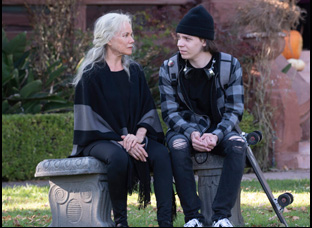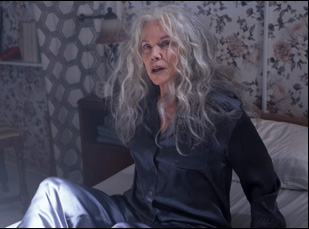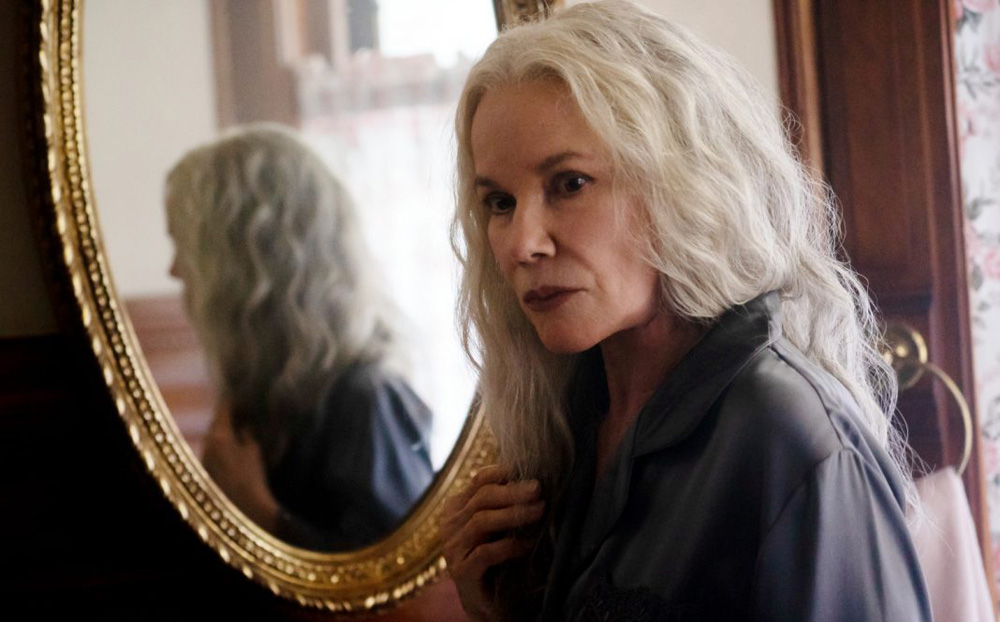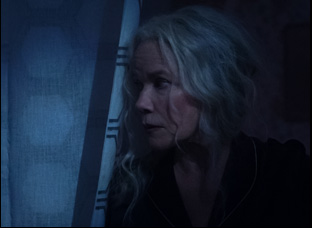It doesn’t seem like much of an imposition when Judith (Barbara Hershey) is asked to give up her phone in “The Manor,” checking herself into a nursing facility where she’s actually looking forward to the peace and quiet it brings.
“So much for all the exciting Insta updates I could’ve posted from here,” she tells her attending nurse Elizabeth, who doesn’t find it as amusing as she does, perhaps a sign of things to come in Axelle Carolyn’s chilling psychological thriller in which the septuagenarian’s suspicion that her health is starting to fail her may lead her into the nursing home, but it’s only once she’s there that she starts looking at a major decline.
“The Manor” surprises from the start when it’s not Judith’s family that’s eager to unload her at the hospice, but willingly signs up to live with a roommate and days where an invitation to play bridge is the height of excitement following a stroke on her 70th birthday causes her to take a tumble. While she’s of sound mind, being in better shape than most at the facility comes at a cost when she has few people to truly connect with and begins to fear that her family will stop by less and less as time goes on, even her beloved grandson Josh (Nicholas Alexander), who has trouble believing she’s been put in a nursing home in the first place.
An additional concern creeps in when she starts to hear strange noises outside her door, inspiring nightmares of a creature comprised of undulating branches that can wrap its arms around her, and as Judith increasingly feels trapped by a staff that is loathe to give reason why they are medicating her a certain way and would rather amp up treatment than to look into the reasons why she might be disturbed, a perfect storm starts to unfold in which whether or not Judith is actually starting to lose her faculties, there is equal question as to if they are intentionally being ripped away from her.
Beyond giving a juicy leading role to Hershey, Carolyn, the writer/director who impressed with her scrappy 2013 debut “Soulmate,” creates quite the showcase for her own ability to tap into people’s deepest fears, taking full advantage of a milieu meant to offer comfort warping into a smothering blanket and losing faith in one’s own judgment after placing trust in the wrong hands. It’s a standout among a new batch of “Welcome to the Blumhouse” thrillers hitting Amazon Prime this week and before the film starts to scare up audiences on streaming, Carolyn spoke about how she went about making a refreshing change of pace for the horror genre and building distinctive elements into its foundation, as well as working with a seasoned pro on the level of Hershey.
It’s an idea I had in my head for a few years before I actually wrote it down and then we shot it like two years ago, so even that process was a while ago, but I was thinking about aging and what it means, and that’s been kind of torturing me ever since I was little trying to wrap my head around our own mortality and the fact that our bodies are going to change and that we can lose our minds as well — the ideas that I think terrify everybody. Then the inevitable happened when my granddad moved to a nursing home, and then my dad also moved to a nursing home and he had dementia, so it was even more intense. When you go through those experiences, one way or another it’s bound to affect you.
There were little things that spark a supernatural story, which is usually the way that I like to interpret the world, and I thought how cool it would be to have a protagonist who’s moving into a nursing home because we so rarely see that, especially older women front a horror movie. We’ve seen a few more lately, which is really exciting like Jamie Lee Curtis in the new “Halloween” movies and Lin Shaye in the “Insidious” movies, but it’s still very unusual and I thought it would be a cool to explore.
Over the years, I’ve heard of others who have had trouble getting films with older casts made, though the names you hear are impressive since there aren’t a lot of great roles out there for older actors. Did you find it was a double-edged sword?
You do and you don’t, because when you get to 70 or 75 and you’ve worked 50 years in your career, there’s an aspect of like, “well fuck it, I’m not going to do a little horror movie.” The ones who have stuck with it for 50 years very often end up like Judi Dench or Maggie Smith, who are going to be in big dramas or do things they feel more worthy and there’s this perception of a horror movie that we had to go against when we’re casting. I was incredibly grateful and very surprised, to be honest, that Barbara Hershey, an absolute legend, would respond so quickly and wanted to see if we got on and could agree on what this movie is trying to say. That’s what we did and she signed on very fast.
It’s a really difficult part because you need to be open to being vulnerable, playing nursing home age, not just physically, but just in your own emotions and then at the same time, convey certain strengths and have someone who has that no nonsense, no bullshit attitude that she has that I like so much, It was generally a blessing to find someone who conveyed all those qualities and also believed in the project so much. Then in terms of getting financing, it is difficult to get production company to trust in you because those characters are untested in some ways and it seems like they have this perception that “why would a 15-year-old boy want to watch a 70-year-old woman on screen?” And the reply is because they go through emotions that are very much at the core of the human experience, being scared because your grandma is getting older.
Was that actually an inspiration for having the teenage grandson Josh in the film, to have an avatar for that viewer?
He was there from the start and his part definitely grew because of how difficult it was to get production companies to kind of back a movie where all the leads were all in their seventies, but it was important for me to have that relationship and to show how she relates to a younger generation. But it was the right thing to do for the story and from a character point of view, and that relationship was very much at the core from the start.

There was even the point where we toyed with the idea that maybe she does have dementia and that she’s fighting against time to solve the issue before she’s unable to get past her own mental abilities falling apart. For a story like this, you’re always going to have an element of “Is it real? Is it not real? Is she doubting herself? Is it in her head?” But it’s such a trope in horror, I thought it would be cool to have her doubt herself at some point, because you need to have that low point, but the most essential part for me is the gaslighting that goes on and the loss of control that happens where little by little, she’s someone who’s very self-possessed at the beginning of the movie — she makes decisions for herself, and she decides to move into that house — and then those little bits of independence are stripped away.
It’s a bit like “Rosemary’s Baby” in a way where like you’re scared because there’s something supernatural, but the terrifying thing is really the way that people around you behave and even if you mean well, we don’t always know how to help someone with dementia or someone who’s getting older who may not be able to communicate the same [as they once did] and all of that is very isolating. I wanted that to be part of the experience that she was going through.
You set up the nursing home in a really wonderful way where all the things that can be inviting about it turn sinister, like the flowery wallpaper and stained glass. What was it like to create?
That’s all down to my awesome production designer Tracy Dishman and my amazing [director of photography] Andrés Sánchez. I hadn’t worked with them before and they both turned out to be superstars and we found the house pretty quickly, but it took a while to actually lock it down and figure out the logistics of how we were going to work in it. The moment that we got it, our production designer went to town and everything that was inside, she stripped it of furniture and completely redesigned the wallpaper. She added all those awesome little knickknacks and there used to be a scene where Judith was still at her house, so you saw what the environment was that she was used to, but I liked that she shows up [to the nursing home], she’s dressed in a way that’s kind of cool and you could see on someone younger, and then she’s in that house with all the wallpaper, being confronted to the typical image of old age, and having a roommate who’s already at a much more advanced stage, so straight away, she’s feeling at odds with her new environment, and then even when she makes that room a little bit more hers, [where] I had good pictures on the wall, there’s that contrast between who she is and where she’s at now and how much of an adjustment it’s going to be, regardless of any monster that might be lurking around the hallways. I have to admit that we shot so much stuff in that room, by the end of it, it was the one room that I sort of hated.
Then again, so does the character.
And there’s so much that takes place in there and trying to keep it fresh and not make it look the exact same every time definitely was a challenge, but I’m very pleased with the result. The rooms downstairs were gorgeous because they had all that wood and there were so many stained-glass windows – the lights hit them perfectly. I could’ve made an entire real estate show based on that house.

The biggest challenge for me was that I used to live in London and I thought it would be set in England, so I had a vision of something that had much more history and much more nature. Then we shot it in L.A. and finding those kinds of trees in Los Angeles is a challenge so you wouldn’t believe that the toughest part was to find the fucking tree [that becomes central to the story]. Originally, it was going to be like a massive oak that stood out in the middle of the clearing and then the tree that we found was on the Disney ranch, just north of L.A. in Santa Clarita, and I wish I could have featured it even more because it’s so cool, but it’s a tree that was struck by lightning, so the tree trunk at the base is hollow, completely dead and yet there’s half the tree that still grows, so it’s like this living dead tree that still keeps blooming and having leaves and even though when you look at the bottom, you can see that it’s completely hollow and we could hide someone inside if we wanted to. It’s bizarre. It’s a weird miracle of nature that we found by complete accident because it’s a Disney ranch — that’s not exactly the part of the ranch they’re advertising.
I won’t spoil the film, but the creature that Judith begins to suspect is stalking her, whether it’s her imagination or not, is brilliantly designed with that nature theme you had in mind. What was it like to figure out what it would look like?
One of the most fun parts of moviemaking is dealing with special effects, prosthetics and fake blood and all that stuff and I had a fairly specific idea of what I wanted because I knew the kind of creature he was going to be and what his purpose was. We called him the minion because he does the bidding of other creatures, which sounds funny when you think of “Despicable Me,” and I don’t give away too much, but I brought the idea to a bunch of companies and when we landed at Illusion Industries, which is Todd Tucker’s company, we had this amazing designer, Martin Astles, who right away, made this fantastic clay bust — I hadn’t even sent them my references yet, but he [said], “This is what it’s inspired for me,” and not only was it awesome to see, but it was really spot on. Every part of [the process], I would bring references for textures and then we would discuss, but Martin would already have been in forests and looked for bark and little pieces of wood, so he’s like, “Here’s what I had in mind. It was just so detailed and so, so beautiful. Then the first day that we shot the monster and I actually saw it on the performer was on Halloween, so it was just the greatest Halloween I’ve ever had. I’ve actually kept the suit, which I’m looking at right now. It’s in my bedroom and I’ve kept the clay concept that they made as well.
I just love that it’s lurking in your bedroom — after seeing the film, nobody else will want it in theirs.
He’s gorgeous — well over six feet. Now that I have the time to look at all the details of the suit, it’s a beautiful piece of work.





